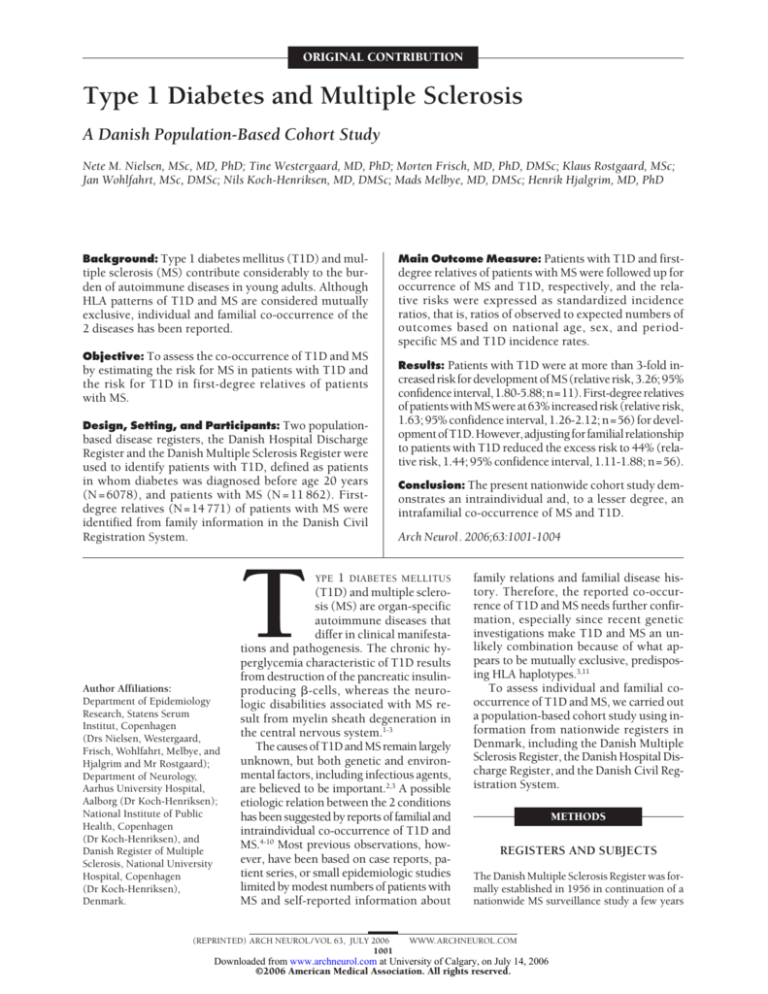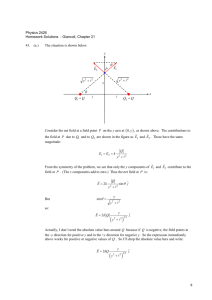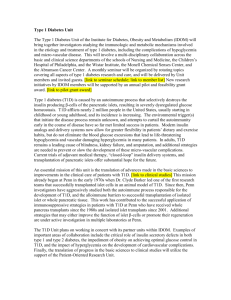
ORIGINAL CONTRIBUTION
Type 1 Diabetes and Multiple Sclerosis
A Danish Population-Based Cohort Study
Nete M. Nielsen, MSc, MD, PhD; Tine Westergaard, MD, PhD; Morten Frisch, MD, PhD, DMSc; Klaus Rostgaard, MSc;
Jan Wohlfahrt, MSc, DMSc; Nils Koch-Henriksen, MD, DMSc; Mads Melbye, MD, DMSc; Henrik Hjalgrim, MD, PhD
Background: Type 1 diabetes mellitus (T1D) and mul-
tiple sclerosis (MS) contribute considerably to the burden of autoimmune diseases in young adults. Although
HLA patterns of T1D and MS are considered mutually
exclusive, individual and familial co-occurrence of the
2 diseases has been reported.
Objective: To assess the co-occurrence of T1D and MS
by estimating the risk for MS in patients with T1D and
the risk for T1D in first-degree relatives of patients
with MS.
Design, Setting, and Participants: Two populationbased disease registers, the Danish Hospital Discharge
Register and the Danish Multiple Sclerosis Register were
used to identify patients with T1D, defined as patients
in whom diabetes was diagnosed before age 20 years
(N = 6078), and patients with MS (N = 11 862). Firstdegree relatives (N = 14 771) of patients with MS were
identified from family information in the Danish Civil
Registration System.
T
Author Affiliations:
Department of Epidemiology
Research, Statens Serum
Institut, Copenhagen
(Drs Nielsen, Westergaard,
Frisch, Wohlfahrt, Melbye, and
Hjalgrim and Mr Rostgaard);
Department of Neurology,
Aarhus University Hospital,
Aalborg (Dr Koch-Henriksen);
National Institute of Public
Health, Copenhagen
(Dr Koch-Henriksen), and
Danish Register of Multiple
Sclerosis, National University
Hospital, Copenhagen
(Dr Koch-Henriksen),
Denmark.
Main Outcome Measure: Patients with T1D and firstdegree relatives of patients with MS were followed up for
occurrence of MS and T1D, respectively, and the relative risks were expressed as standardized incidence
ratios, that is, ratios of observed to expected numbers of
outcomes based on national age, sex, and periodspecific MS and T1D incidence rates.
Results: Patients with T1D were at more than 3-fold increased risk for development of MS (relative risk, 3.26; 95%
confidence interval, 1.80-5.88; n=11). First-degree relatives
of patients with MS were at 63% increased risk (relative risk,
1.63; 95% confidence interval, 1.26-2.12; n=56) for development of T1D. However, adjusting for familial relationship
to patients with T1D reduced the excess risk to 44% (relative risk, 1.44; 95% confidence interval, 1.11-1.88; n=56).
Conclusion: The present nationwide cohort study demonstrates an intraindividual and, to a lesser degree, an
intrafamilial co-occurrence of MS and T1D.
Arch Neurol. 2006;63:1001-1004
YPE 1 DIABETES MELLITUS
(T1D) and multiple sclerosis (MS) are organ-specific
autoimmune diseases that
differ in clinical manifestations and pathogenesis. The chronic hyperglycemia characteristic of T1D results
from destruction of the pancreatic insulinproducing -cells, whereas the neurologic disabilities associated with MS result from myelin sheath degeneration in
the central nervous system.1-3
The causes of T1D and MS remain largely
unknown, but both genetic and environmental factors, including infectious agents,
are believed to be important.2,3 A possible
etiologic relation between the 2 conditions
has been suggested by reports of familial and
intraindividual co-occurrence of T1D and
MS.4-10 Most previous observations, however, have been based on case reports, patient series, or small epidemiologic studies
limited by modest numbers of patients with
MS and self-reported information about
(REPRINTED) ARCH NEUROL / VOL 63, JULY 2006
1001
family relations and familial disease history. Therefore, the reported co-occurrence of T1D and MS needs further confirmation, especially since recent genetic
investigations make T1D and MS an unlikely combination because of what appears to be mutually exclusive, predisposing HLA haplotypes.3,11
To assess individual and familial cooccurrence of T1D and MS, we carried out
a population-based cohort study using information from nationwide registers in
Denmark, including the Danish Multiple
Sclerosis Register, the Danish Hospital Discharge Register, and the Danish Civil Registration System.
METHODS
REGISTERS AND SUBJECTS
The Danish Multiple Sclerosis Register was formally established in 1956 in continuation of a
nationwide MS surveillance study a few years
WWW.ARCHNEUROL.COM
Downloaded from www.archneurol.com at University of Calgary, on July 14, 2006
©2006 American Medical Association. All rights reserved.
earlier. The register has since collected information about patients with MS from all departments of neurology, neuropathology, practicing neurologists, MS rehabilitation centers, death certificates, and, since 1977, the Danish Hospital Discharge Register.
Cases with onset before 1994 were classified according to the
diagnostic criteria of Allison and Millar, whereas cases with onset in or after 1994 were classified according to those of Poser,
including possible MS.12 Since its inception, only 3 neurologists
have been involved in the classification of MS cases in the Danish Multiple Sclerosis Register.
The Danish Civil Registration System was established on April
1, 1968, and has since assigned a unique personal identification number to all Danish residents. The Civil Registration System contains continuously updated information on vital status, residence, place of birth, and, for most individuals born
since the beginning of the 1950s, information about family relations, enabling us to identify first-degree relatives.13
The Danish Hospital Discharge Register contains information on all nonpsychiatric hospitalizations in Denmark since January 1977, including outpatient treatments since 1995. Individual information on dates of admission and discharge, diagnoses,
and surgical procedures is recorded for every hospitalization. Between 1977 and 1993, diagnoses were classified according to the
World Health Organization ICD-8 (International Classification
of Diseases, Eighth Revision), and since 1994, according to the
ICD-10 (International Statistical Classification of Diseases and
Health-related Problems, 10th Revision). No distinction was made
between insulin-dependent diabetes mellitus and non–insulindependent diabetes mellitus before 1987 (ICD-8 code 250 for
both types of diabetes). From 1987 to 1998, insulin-dependent
diabetes mellitus was coded as 249 (ICD-8; 1987-1993) or E10
(ICD-10; 1994-present) and non–insulin-dependent diabetes
mellitus as 250 (ICD-8; 1987-1993) or E11 (ICD-10; 1994present). Although most cases of T1D and type 2 diabetes will
be coded as insulin-dependent diabetes mellitus and non–insulindependent diabetes mellitus, respectively, some patients with type
2 diabetes will need insulin treatment and might, therefore, be
inaccurately categorized as having insulin-dependent diabetes.
Accordingly, the diagnostic classification used by the Danish Hospital Discharge Register does not enable a clear distinction between T1D and type 2 diabetes. However, in Leeds, England, most
patients with diabetes (97%) diagnosed before age 20 years had
T1D.14 We, therefore, used age less than 20 years at the time of
first diagnosis of diabetes to identify our patients with T1D. Primary and secondary diagnoses of T1D in inpatients and outpatients were included in the present study.
DATA ANALYSIS
Risk for MS After T1D
To identify patients with MS among those with T1D, we linked
the cohort of patients with T1D who were younger than 20 years
at establishment of the Danish Hospital Discharge Register in
1977 (ie, those born since January 1, 1957) to the Multiple Sclerosis Register, using each individual’s unique personal identification number as key. Follow-up started on the date of T1D
diagnosis plus 1 year and ended on the date of MS diagnosis,
death, emigration, or December 31, 1997, whichever came first.
The standardized incidence ratio, that is, the ratio of observed
to expected numbers of patients with MS in the cohort, served
as a measure of relative risk (RR). The expected numbers of
patients with MS were calculated as the sum of sex-, age-, and
period-specific person-years at risk in the T1D cohort multiplied by corresponding national sex-, age-, and periodspecific MS incidence rates available from the Danish Multiple
Sclerosis Register. Ninety-five percent confidence intervals (CIs)
(REPRINTED) ARCH NEUROL / VOL 63, JULY 2006
1002
for the RRs were estimated from the Wald test, assuming a Poisson distribution of the observed cases.
Risk for T1D in Families Afflicted With MS
To identify our cohort of first-degree relatives of patients with
MS, we searched the files of the Danish Multiple Sclerosis Register to identify all patients in whom MS was diagnosed between April 1, 1968, and before December 31, 1997. Information about first-degree relatives born since January 1, 1957, of
the same generation (siblings) or younger generation (offspring) was obtained through the Civil Registration System. The
cohort of first-degree relatives was followed up for diagnosis
of T1D in the Danish Hospital Discharge Register from January 1, 1977, or birth, whichever came later, until diagnosis of
T1D, death, 20th birthday, emigration, or December 31, 2001,
whichever came first. The standardized incidence ratio, that is,
the ratio of observed to expected numbers of patients with T1D,
served as the measure of RR for T1D in the cohort of firstdegree relatives of patients with MS. The expected number of
patients with T1D was calculated as the sum of the sex-, age-,
and period-specific person-years at risk in the cohort of firstdegree relatives multiplied by corresponding national sex-, age-,
and period-specific T1D incidence rates generated from the Danish Hospital Discharge Register.
The risk estimates for T1D in first-degree relatives of patients with MS could be affected by an excess risk for T1D in
first-degree relatives of patients with T1D if MS and T1D are
related. Therefore, in an additional analysis, we adjusted for
first-degree family relationship to patients with T1D by modifying the calculation of the expected number of cases, as follows: patients with T1D and their first-degree relatives were
identified from the Danish Hospital Discharge Register and the
Civil Registration System, respectively. An overall estimate of
the RR for T1D in first-degree relatives of patients with T1D
was calculated in an exercise similar to the preceding one concerning the risk for T1D in relatives of patients with MS. The
first person with T1D in a family was considered the proband,
and only the nonproband family members were followed up
for the occurrence of T1D, from January 1, 1977, or birth, whichever came later, until diagnosis of T1D, death, 20th birthday,
emigration, or December 31, 2001, whichever came first. Overall, first-degree relatives of patients with T1D were at 15.6fold increased risk for development of T1D compared with persons without patients with T1D among their first-degree relatives.
The information on familial relationship with patients with T1D
was subsequently included in a new analysis. Accordingly, the
contributions to the expected numbers of patients with T1D
from first-degree relatives, who in addition to being related to
a patient with MS also were related to a patient with T1D, were
multiplied by 15.6; all other contributions were unaltered.
RESULTS
RISK FOR MS IN PATIENTS WITH T1D
We observed 11 patients with MS among 6078 patients
with T1D during 71 626 person-years of follow-up when
only 3.38 cases were expected (RR, 3.26; 95% CI, 1.805.88). In these 11 patients, T1D and MS were diagnosed
at a mean±SD age of 13.3±3.4 years and 25.4±4.9 years,
respectively. The diagnosis of MS was clinically definite
in 7 patients, probable in 3 patients, and possible in 1
patient. Similar results were obtained in the analyses restricted to clinically definite MS cases or clinically defiWWW.ARCHNEUROL.COM
Downloaded from www.archneurol.com at University of Calgary, on July 14, 2006
©2006 American Medical Association. All rights reserved.
Table. Relative Risk (RR) for Type 1 Diabetes Mellitus Diagnosed Before Age 20 Years in a Cohort of 14 771 First-degree Relatives
(Siblings and Offspring) of Patients With MS
Cohort
First-degree Relatives
of Patients With MS
Offspring
Male
Female
Total
Siblings
Male
Female
Total
Overall
Male
Female
Total
RR for T1D
Adjusted RR for T1D*
No.
Person-Years
Observed, n
Expected, n
RR (95% CI)
Observed, n
Expected, n
RR (95% CI)
6249
5901
12 150
70 941
67 013
137 954
25
23
48
15.59
12.95
28.54
1.60 (1.08-2.37)
1.78 (1.18-2.67)
1.68 (1.27-2.23)
25
23
48
17.35
14.45
31.81†
1.44 (0.97-2.13)
1.59 (1.06-2.39)
1.51 (1.14-2.00)
1299
1322
2621
10 975
11 371
22 347†
3
5
8
2.99
2.79
5.78
1.00 (0.32-3.11)
1.79 (0.75-4.31)
1.38 (0.69-2.77)
3
5
8
3.63
3.32
6.95
0.83 (0.27-2.56)
1.51 (0.63-3.62)
1.15 (0.58-2.30)
7548
7223
14 771
81 916
78 385
160 300†
28
28
56
18.58
15.73
34.32†
1.51 (1.04-2.18)
1.78 (1.23-2.58)
1.63 (1.26-2.12)
28
28
56
20.98
17.78
38.76
1.33 (0.92-1.93)
1.58 (1.09-2.28)
1.44 (1.11-1.88)
Abbreviations: CI, confidence interval; MS, multiple sclerosis; RR, relative risk; T1D, type 1 diabetes mellitus.
*Adjusted for relationship to patients with T1D.
†Totals do not sum because of rounding.
nite plus probable MS cases. The RR estimate was slightly
lower in women (RR, 2.69; 95% CI, 1.21-5.98; n=6) than
in men (RR, 4.36; 95% CI, 1.82-10.48; n=5), but this difference was not statistically significant (P= .4). The RR
in patients having diabetes diagnosed before age 15 years
was 4.23 (95% CI, 1.90-9.43; n = 6).
RISK FOR T1D IN FIRST-DEGREE RELATIVES
OF PATIENTS WITH MS
Overall, 14 771 offspring and siblings born since January
1, 1957, were identified for 11 862 patients with MS. These
first-degree relatives had 63% increased risk of developing T1D (RR, 1.63; 95% CI, 1.26-2.12), with no significant difference between the sexes (Table). The RR for T1D
was the same in offspring (RR, 1.68; 95% CI, 1.27-2.23;
n=48) and in siblings (RR, 1.38; 95% CI, 0.69-2.77; n=8;
P=.6; Table). The increased risk was uniformly distributed in follow-up periods before and after MS in the proband (P=.4). The excess risk of developing T1D in offspring and siblings of patients with MS was, however, partly
explained because some of the first-degree relatives, in addition to being related to a patient with MS, were also related to a patient with T1D. Adjusting for first-degree family relationship to patients with T1D reduced the overall
excess risk slightly (RR, 1.44; 95% CI, 1.11-1.88).
Hospital records were available for 62 (93%) of 67 T1D
cases that were linked with MS in our study. All patients
except 1 had typical T1D. This patient, who was overweight, was diagnosed as having diabetes at age 17 years
and was treated with oral antidiabetic medication. In conjunction with an episode of ketoacidosis at the age of 26
years, insulin therapy was initiated and continued for at
least 10 years. A C-peptide measurement was compatible with a diagnosis of T1D.
COMMENT
We used 3 population-based disease registers to assess cooccurrence of T1D and MS. Our analyses showed that pa(REPRINTED) ARCH NEUROL / VOL 63, JULY 2006
1003
tients with T1D are at 3-fold increased risk for development of MS and that the risk for T1D in first-degree relatives
of patients with MS is increased by approximately 40%.
Our findings are compatible with a recent Sardinian
study in which 5-fold and 2-fold higher prevalences of
T1D were observed in patients with MS and their firstdegree relatives (parents, siblings), respectively, compared with the general population.9 Our risk estimates
for female patients with T1D are, however, lower than
preliminary results from the Familial Autoimmune and
Diabetes study in the United States, in which women diagnosed as having diabetes before age 17 years had a 20fold increase in the prevalence of MS.4 As in our study,
familial co-occurrence of T1D could not explain the increased risk for T1D in first-degree relatives of patients
with MS in the Sardinian study.9
Patients with T1D are typically in close contact with
the health care system. The patients with T1D who developed MS (n=11) tended to be slightly younger when
diagnosed as having MS compared with other patients
with MS born in the same period. However, the interval
between onset and diagnosis of MS was no shorter in the
11 patients with both diseases, which would have been
expected if surveillance bias should explain our results.
Type 1 diabetes mellitus may result in diabetic neuropathy, which may mimic early symptoms of MS, and, accordingly, diagnostic misclassification between T1D and
MS could occur. However, we obtained information on
MS from the Danish Multiple Sclerosis Register, in which
all reports undergo individual evaluation by experienced neurologists.12 Consequently, we consider diagnostic misclassification an unlikely explanation for the
observed association between T1D and MS.
In our study we defined T1D as diabetes mellitus diagnosed before age 20 years. Despite growing incidence
rates of type 2 diabetes in Europe, the risk in children
and adolescents remains low in comparison with T1D.14,15
Moreover, we confirmed the diagnosis of T1D in all 62
available patient records. Although we cannot entirely
rule out that our approximation of T1D may have imWWW.ARCHNEUROL.COM
Downloaded from www.archneurol.com at University of Calgary, on July 14, 2006
©2006 American Medical Association. All rights reserved.
plied inclusion of some type 2 diabetes cases, we consider this of no significance to our observations.
Inasmuch as almost every patient having newly diagnosed T1D will be admitted to a hospital ward or an outpatient clinic, the completeness of the Danish Hospital
Discharge Register regarding T1D is considered high.16
Furthermore, we used information from 3 independent
registers to ascertain the intraindividual and intrafamilial co-occurrence of MS and T1D. Thereby, we avoided
bias resulting from differences in recall of family histories of diseases between cases and controls, which may
have affected previous studies.5,7,9,17
Because of what seems to be mutually exclusive, predisposing HLA haplotypes in patients with T1D and MS,
the co-occurrence of MS and T1D has been considered unlikely.11 However, genetic susceptibility to autoimmune
diseases is complex and involves several genes.18 Since MSand T1D-associated HLA haplotypes differ between
populations, HLA class II alleles per se may not alone be
responsible for disease susceptibility.19,20 It has been suggested that variation at other non-HLA class II loci and/or
unknown environmental factors might contribute significantly to the co-occurrence of these 2 diseases.21,22
Several similarities in immunologic features of T1D
and MS may also suggest overlapping causes. Both T1D
and MS are considered T-cell–mediated autoimmune disorders1 characterized by autoantigen-specific T1-helper
cell responses, 23 decreased T-cell suppressor activity,10,24,25 and the presence of various autoantibodies, some
of which could operate in both diseases.2,26-28 Also, Winer
et al1 recently demonstrated that autoreactive T cells were
capable of targeting both pancreatic islet and central nervous system autoantigens in patients with MS, patients
with T1D, and relatives of patients with T1D.
To our knowledge, the present study is the first truly
nationwide cohort study to demonstrate intraindividual and,
to a lesser degree, intrafamilial co-occurrence of MS and
T1D. The underlying mechanisms remain unknown but
may involve both genetic and environmental factors.
Accepted for Publication: April 3, 2006.
Correspondence: Nete M. Nielsen, MSc, MD, PhD,
Department of Epidemiology Research, Statens Serum
Institut, Artillerivej 5, 2300 Copenhagen S Denmark
(NMN@ssi.dk).
Author Contributions: Study concept and design: Nielsen,
Westergaard, Frisch, Wohlfahrt, Melbye, Hjalgrim. Acquisition of data: Nielsen, Westergaard, Frisch, KochHenriksen. Analysis and interpretation of data: Nielsen,
Westergaard, Frisch, Rostgaard, Wohlfahrt, Melbye,
Hjalgrim. Drafting of the manuscript: Nielsen, Rostgaard,
Hjalgrim. Critical revision of the manuscript for important intellectual content: Westergaard, Frisch, Rostgaard,
Wohlfahrt, Koch-Henriksen, Melbye, Hjalgrim. Statistical analysis: Nielsen, Rostgaard, Wohlfahrt, KochHenriksen. Obtained funding: Nielsen, Westergaard. Administrative, technical, and material support: Melbye. Study
supervision: Westergaard, Frisch, Melbye, Hjalgrim.
Funding/Support: This study was supported by the Danish Medical Research Council, the Lundbeck Foundation, the Augustinus Foundation, and the Danish Multiple Sclerosis Society.
(REPRINTED) ARCH NEUROL / VOL 63, JULY 2006
1004
REFERENCES
1. Winer S, Astsaturov I, Cheung R, et al. Type I diabetes and multiple sclerosis
patients target islet plus central nervous system autoantigens: nonimmunized
nonobese diabetic mice can develop autoimmune encephalitis. J Immunol. 2001;
166:2831-2841.
2. Noseworthy JH, Lucchinetti C, Rodriguez M, Weinshenker BG. Multiple sclerosis.
N Engl J Med. 2000;343:938-952.
3. Atkinson MA, Eisenbarth GS. Type 1 diabetes: new perspectives on disease pathogenesis and treatment. Lancet. 2001;358:221-229.
4. Dorman JS, Steenkiste AR, Burke JP, Songini M. Type 1 diabetes and multiple
sclerosis: together at last. Diabetes Care. 2003;26:3192-3193.
5. Warren S, Cockerill R, Warren KG. Risk factors by onset age in multiple sclerosis.
Neuroepidemiology. 1991;10:9-17.
6. Heinzlef O, Alamowitch S, Sazdovitch V, et al. Autoimmune diseases in families of
French patients with multiple sclerosis. Acta Neurol Scand. 2000;101:36-40.
7. Henderson RD, Bain CJ, Pender MP. The occurrence of autoimmune diseases in
patients with multiple sclerosis and their families. J Clin Neurosci. 2000;7:
434-437.
8. Jaworski MA, Severini A, Mansour G, et al. Inherited diseases in North American Mennonites: focus on Old Colony (Chortitza) Mennonites. Am J Med Genet.
1989;32:158-168.
9. Marrosu MG, Cocco E, Lai M, Spinicci G, Pischedda MP, Contu P. Patients with
multiple sclerosis and risk of type 1 diabetes mellitus in Sardinia, Italy: a cohort
study. Lancet. 2002;359:1461-1465.
10. Wertman E, Zilber N, Abramsky O. An association between multiple sclerosis and
type I diabetes mellitus. J Neurol. 1992;239:43-45.
11. Lernmark A. Multiple sclerosis and type 1 diabetes: an unlikely alliance. Lancet.
2002;359:1450-1451.
12. Koch-Henriksen N, Rasmussen S, Stenager E, Madsen M. The Danish Multiple
Sclerosis Registry: history, data collection and validity. Dan Med Bull. 2001;
48:91-94.
13. Westergaard T. Birth Order and Cancer Risk [doctoral thesis]. Copenhagen, Denmark: University of Copenhagen; 1997.
14. Feltbower RG, McKinney PA, Campbell FM, Stephenson CR, Bodansky HJ.
Type 2 and other forms of diabetes in 0-30 year olds: a hospital based study in
Leeds, UK. Arch Dis Child. 2003;88:676-679.
15. Poulsen MK, Jacobsen BB. Type 2 diabetes in children and adolescents [in Danish].
Ugeskr Laeger. 2005;167:489-493.
16. Nielsen GL, Sorensen HT, Pedersen AB, Sabroe S. Analyses of data quality in registries concerning diabetes mellitus: a comparison between a population based hospital discharge and an insulin prescription registry. J Med Syst. 1996;20:1-10.
17. Broadley SA, Deans J, Sawcer SJ, Clayton D, Compston DA. Autoimmune disease in first-degree relatives of patients with multiple sclerosis: a UK survey. Brain.
2000;123:1102-1111.
18. Heward J, Gough SC. Genetic susceptibility to the development of autoimmune
disease. Clin Sci (Lond). 1997;93:479-491.
19. Marrosu MG, Murru MR, Costa G, Murru R, Muntoni F, Cucca F. DRB1-DQA1DQB1 loci and multiple sclerosis predisposition in the Sardinian population. Hum
Mol Genet. 1998;7:1235-1237.
20. Karges WJ, Ilonen J, Robinson BH, Dosch HM. Self and non-self antigen in diabetic autoimmunity: molecules and mechanisms. Mol Aspects Med. 1995;
16:79-213.
21. Merriman TR, Cordell HJ, Eaves IA, et al. Suggestive evidence for association of
human chromosome 18q12-q21 and its orthologue on rat and mouse chromosome 18 with several autoimmune diseases. Diabetes. 2001;50:184-194.
22. Marrosu MG, Motzo C, Murru R, et al. The co-inheritance of type 1 diabetes and
multiple sclerosis in Sardinia cannot be explained by genotype variation in the
HLA region alone. Hum Mol Genet. 2004;13:2919-2924.
23. Romagnani S. Biology of human TH1 and TH2 cells. J Clin Immunol. 1995;15:
121-129.
24. Hauser SL, Goodkin DE. Multiple sclerosis and other demyelinating diseases.
In: Fauci AS, Braunwald E, Isselbacher KJ, et al, eds. Harrison’s Principles of
Internal Medicine. 14th ed. New York: McGraw-Hill Companies Health Professional Division; 1998.
25. Cahill GF Jr, McDevitt HO. Insulin-dependent diabetes mellitus: the initial lesion.
N Engl J Med. 1981;304:1454-1465.
26. Hermitte L, Martin-Moutot N, Boucraut J, et al. Humoral immunity against glutamic acid decarboxylase and tyrosine phosphatase IA-2 in Lambert-Eaton myasthenic syndrome. J Clin Immunol. 2000;20:287-293.
27. Knip M, Kukko M, Kulmala P, et al. Humoral beta-cell autoimmunity in relation
to HLA-defined disease susceptibility in preclinical and clinical type 1 diabetes.
Am J Med Genet. 2002;115:48-54.
28. Raine CS, Cannella B, Hauser SL, Genain CP. Demyelination in primate autoimmune encephalomyelitis and acute multiple sclerosis lesions: a case for antigenspecific antibody mediation. Ann Neurol. 1999;46:144-160.
WWW.ARCHNEUROL.COM
Downloaded from www.archneurol.com at University of Calgary, on July 14, 2006
©2006 American Medical Association. All rights reserved.










